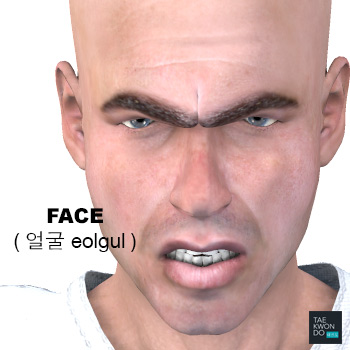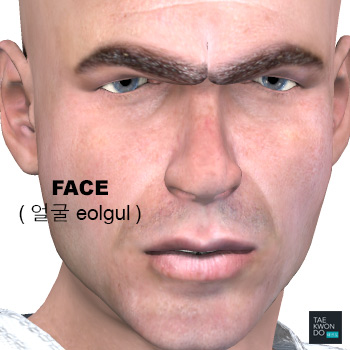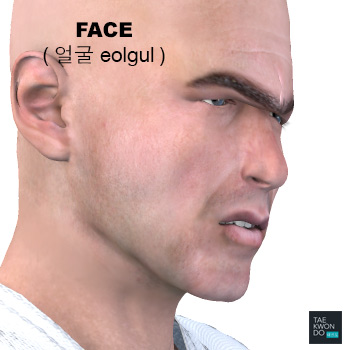Taekwondo 태권도Taekwondo Preschool
Promotion from one geup to the next can proceed rapidly in some schools, since schools often allow geup promotions every two, three, or four months. Students of geup rank learn the most basic techniques first, and then move on to more advanced techniques as they approach first dan. Many of the older and more traditional schools often take longer to allow students to test for higher ranks than newer, more contemporary schools, as they may not have the required testing intervals. View Taekwondo belt levels »

Face
( 얼굴 eolgul )
Difficulty Level: Beginner Surface: Offensive Target
The face ( 얼굴 eolgul ) is the anterior part of the head, containing the eyes, nose, and mouth. The face is itself a highly sensitive region of the human body and its expression may change when the brain is stimulated by any of the many human senses, such as touch, temperature, smell, taste, hearing, movement, hunger, or visual stimuli.
The front of the human head is called the face. It includes several distinct areas, of which the main features are:
- The forehead, comprising the skin beneath the hairline, bordered laterally by the temples and inferiorly by eyebrows and ears
- The eyes, sitting in the orbit and protected by eyelids and eyelashes
- The distinctive human nose shape, nostrils, and nasal septum
- The cheeks, covering the maxilla and mandibula (or jaw), the extremity of which is the chin
- The mouth, with the upper lip divided by the philtrum, sometimes revealing the teeth
- Facial appearance is vital for human recognition and communication. Facial muscles in humans allow expression of emotions.
The shape of the face is influenced by the bone-structure of the skull, and each face is unique through the anatomical variation present in the bones of the viscerocranium (and neurocranium). The bones involved in shaping the face are mainly the maxilla, mandible, nasal bone and zygomatic bone. Also important are various soft tissues, such as fat, hair and skin (of which color may vary).
* Please see a certified Master Instructor ( 사범님 sabeomnim ) for training. Proper guidance and instructions are needed to ensure safe training.

Impact Surface Area
Various surfaces of the hand and feet may be engaged as the striking or blocking surface depending on which area of the opponents body is being targeted. This leads to a large array of hand and feet positions. The human body's shape is determined by a strong skeleton made of bone and cartilage, surrounded by fat, muscle, connective tissue, organs, and other structures. For more information View Impact Surface Area »
- Fist ( 주먹 jumeok )
- Hammer Fist ( 메주먹 mejumeok )
- Hand Blade ( 손날 sonnal )
- Ridgehand ( 손날등 sonnal-deung )
- Forearm ( 앞팔 ap-pal )
- Inner Wrist ( 안팔목 anpalmok )
- Outside Wrist ( 바깥팔목 bakkatpalmok )
- Elbow ( 팔굽 palgup )
- Back Knuckle ( 등주먹 deung-jumeok )
- Arm ( 팔 pal )
- Hand ( 손 son )
- Finger ( 손가락 songalag )
- Palm ( 손바닥 sonbadak )
- Palm Heel ( 바탕손 batangson )
- Fingertips ( 손끝 sonkkeut )
- Scissors Fingertips ( 가위손끝 kawisonkkeut )
- Combined Two Fingertips ( 모은두손끝 moeundusonkkeut )
- Single Fingertip ( 한손끝 hansonkkeut )
- Combined Three Fingertips ( 모은세손끝 moeunsesonkkeut )
- Flat Fingertips ( 편손끝 pyeonsonkkeut )
- Back Hand ( 손등 sondeung )
- Wrist Area ( 팔목 palmok )
- Back of the Wrist ( 등팔목 deung-palmok )
- Base of the Wrist or Inner Wrist ( 밑팔목 mitpalmok )
- Arc Hand ( 아금손 ageumson )
- Pincers Finger ( 집게주먹 jipgejumeok )
- Bent Wrist ( 굽힌손목 gupinsonmok )
- Curled Fingertips ( 모둠손끝 modumsonkkeut )
- Extended Knuckle Fist ( 밤주먹 bamjumeok )
- Half-clenched Fist ( 편주먹 pyeonjumeok )
- Trigger Finger Fist ( 집게밤주먹 jipgebamjumeok )
- Curled Hand ( 곰손 gomson )
- Foot ( 발 bal )
- Ball of the Foot ( 앞축 apchuk )
- Instep of the Foot ( 발등 baldeung )
- Bottom of the Heel ( 뒤축 dwichuk )
- Sole of the Foot ( 발바닥 balbadak )
- Foot Blade ( 발날 balnal )
- Shin ( 정강이 jeonggangi )
- Ankle ( 발목 balmog )
- Reverse Foot Blade ( 발날등 balnaldeung )
- Tips of the Toes ( 발끝 balkkeut )
- Knee ( 무릎 mureup )
- Back of the Heel ( 뒤꿈치 dwikkumchi )
- Back of the Knee ( 오금 ogum )
- Thigh ( 허벅지 heobeokji )
- Head ( 머리 meoli )
- Face ( 얼굴 eolgul )
- Human Eye ( 눈 nun )
- Ear ( 귀 gwi )
- Temple ( 관자놀이 gwanjanoli )
- Nose ( 코 ko )
- Teeth ( 이 i )
- Chin ( 턱 teog )
- Jaw ( 턱 teog )
- Throat ( 목구멍 mokgumeong )
- Neck ( 목 mok )
- Cervical Vertebrae ( 경추 gyeongchu )
- Shoulder ( 어깨 eokkae )
- Collarbone ( 쇄골 swaegol )
- Chest ( 가슴 gaseum )
- Ribs ( 늑골 neuggol )
- Sternum ( 흉골 hyung-gol )
- Abdomen ( 복부 bogbu )
- Groin ( 샅 sat )
- Hamstring ( 햄스트링 haemseuteuling )
There are five tenets defined in the International Taekwondo Federation (ITF) and several more in World Taekwondo (WT).
Integrity ( 염치 yeom-chi ): "Although it may be similar, this form of integrity takes on a more wider role then defined in the common dictionary. In taekwondo, integrity means not only to determine what is right or wrong but also having the conscience to feel guilt if one has done wrong and to have the integrity stand up for what is right." View Taekwondo Tenets »
RESOURCES
This article uses material from the Wikipedia articles "Face" and "List of Taekwondo techniques", which is released under the Creative Commons Attribution-Share-Alike License 3.0.
































